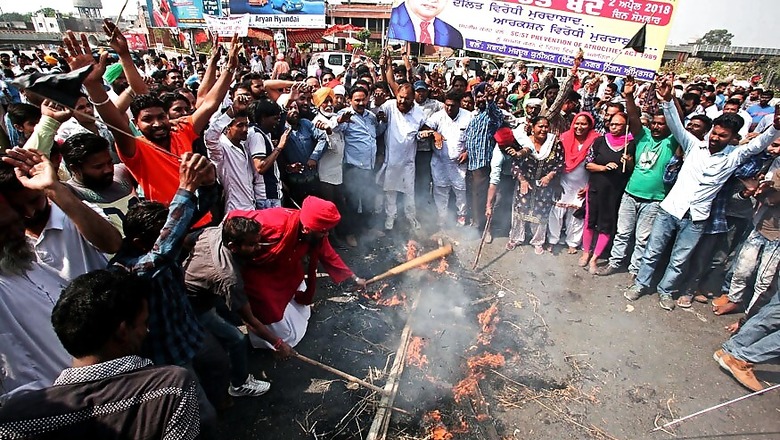
views
Washington: The Bharat Bandh on April 2 called by Dalit groups was a result of the successful use of artificial intelligence (AI), the geographic information system (GIS) and big data, according to a core group of US-based Dalit activists.
The protest, which surprised many because of its sudden eruption, was organised against the alleged dilution of the SC/ST (Prevention of Atrocities) Act.
New Jersey-based Deelip Mhaske, who heads a secretive network of some 100 overseas Dalit activists based in the US, the UK, Australia and the Middle East said the protest shows that Dalits no longer need to be affiliated to any political establishment.
"A new era for Dalit politics has begun by adopting artificial intelligence, the GIS and social media," Mhaske told PTI in an interview as he gave an insight into how Dalit groups were mobilised during the protest. Most of these Dalit activists in the secretive group are from the IT sector and work in some of the top info-tech companies. Except for Mhaske, who has formed the Foundation for Human Horizon out of New York, no one wished to be identified.
Several of them who spoke to PTI on condition of anonymity, said that over the past three years, they have worked to create a social-media based network of like-minded Dalit activists across India, who are primarily focused in 100 parliamentary constituency in six politically crucial states of Uttar Pradesh, Madhya Pradesh, Rajasthan, Bihar and Maharashtra. "April 2 Bharat Bandh was a trial run. It was successful," Mhaske said.
Over the past few years, the group has used artificial intelligence to harvest millions of publicly available data and those from the social media platforms like Facebook to identify and target the groups to foment unrest against certain political groups. Mhaske claimed in the last three years, the group has spent between USD 300,000-USD 500,000 in purchasing relevant data from social media. One of the recent ones was purchased from a London-based company. But, members of the group insist that this is "certainly not" from the UK-based Cambridge Analytica, which is at the centre of Facebook's data scandal.
According to the 56-page 'Social Media and Dalit Atrocities: A report on social media strategy for Dalit Advocacy Group' prepared by this London-based data analytics firm, Dalits have potential to influence 100 constituency using social media, making them the game changers of the 2019 Lok Sabha elections. An abridged version of the report was with PTI. For about a week, the PTI was also given access to some of the closed WhatsApp and Telegraph groups created in various parts of the country to give a sense of the modus-operandi and nature of work of these overseas Dalit activists and how they are using these social media platform to further their cause. The access has now been withdrawn.
The report says that the Dalit's social media usage is now sufficiently widespread to have the power to influence the outcome of the 100 seats in the next Lok Sabha elections and consequently government formation. Social media strategy can empower Dalits to eliminate caste-based atrocities as well as increase their participation in the policy making, the report said, emphasising the need for Dalit advocates to draw evidence-based social media strategies to connect Dalits.
A London-based Dalit activist said the April 2 Bharat Bandh was a trial run for "peer-to-peer" targeting, as now it believes that the mobile revolution in India has created enough critical mass of social media users.
Initially, the plan was to test waters on April 14, the birth anniversary of Babasaheb Ambedkar, by a nationwide instant protest.However, the group decided to give it a trial run on April 2 following a Supreme Court verdict, which created a sense of anger among Dalits. Giving an insight into the network, one of the IT experts from the group said that the census and election commission data on electorate was collected and compared with the data published by Facebook on their website."We culled the data from this page, constituency by constituency, one constituency at a time," the Dalit IT expert said.
"The use of GIS in social mapping is new technology and not tested before with the vulnerable population like Dalits," the report said. Mhaske said the data analytics and social media company hired to analyse the caste atrocities relationship to the people's social media post, government responses and unrested areas socio-political issues, including the political representations, found no relationship between the elected political leaders or party affiliation and increase in the atrocities.
The Supreme Court had on March 20 diluted certain provisions of the SC/ST Prevention of Atrocities Act, in a bid to protect 'honest' public servants discharging bona fide duties from being blackmailed with false cases under the Act.The apex court's verdict is being widely criticised by the Dalits and the Opposition who claim that the dilution of the Act will lead to more discrimination and crimes against the backward community.
After the Supreme Court's verdict, a detailed social media plan was created and feed was sent to the local groups in 100 Lok Sabha constituencies.
"People joined the call without knowing who is calling it. 'Bharat Bandh' was called through social media using Artificial Intelligence and social media technology," Mhaske said.


















Comments
0 comment